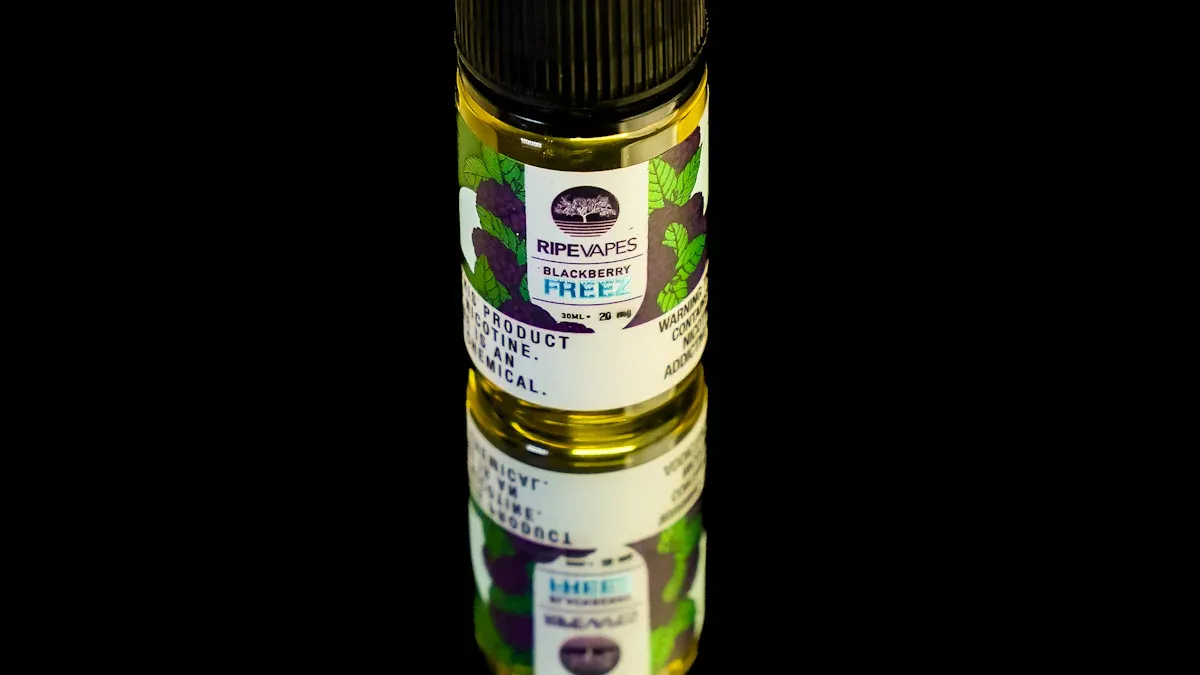What is e-liquid in vaping?

E-liquid is the main part of vaping. It powers your e-cigarette or vape device. It gives you flavor and nicotine if you want it. The main ingredients are Propylene Glycol (PG), Vegetable Glycerin (VG), flavorings, and optional nicotine. Knowing these parts helps you make smart choices about vaping.
Key Takeaways
E-liquids have Propylene Glycol (PG), Vegetable Glycerin (VG), flavors, and sometimes nicotine. These ingredients change the taste, vapor, and throat feel.
Vaping can cause health issues like breathing problems and addiction to nicotine. It is important to pick trusted brands and understand the risks.
Safety rules say there must be clear labels and child-proof caps. However, some products might still have harmful things. So, stay informed and careful.
E-liquid Ingredients

E-liquids have important ingredients that affect your vaping. Knowing these parts helps you choose better products.
Base Liquids
The main liquids in e-liquids are Propylene Glycol (PG) and Vegetable Glycerin (VG). These two make up most vape juices.
Propylene Glycol (PG): This is a clear, thin liquid. It makes flavors stronger and gives a throat hit like smoking. PG is low in toxicity and safe to eat. But when heated, it can create harmful substances, especially at high heat.
Vegetable Glycerin (VG): VG is thicker and sweeter than PG. It makes bigger vapor clouds, which many vapers like. VG is also safe to eat, but it can create larger aerosol particles. This might change how nicotine is delivered.
The mix of PG and VG can be very different in e-liquids. It can be 100% PG or 100% VG. Many e-liquids use a mix of both for good flavor and vapor. A common mix is 70% VG and 30% PG, which gives a nice balance of flavor and vapor.
Flavorings
Flavorings are very important for making vaping fun. They can turn a basic e-liquid into something special. Here are some popular flavor types:
Flavor Category | Common Flavoring Agents |
|---|---|
Tobacco | Ethyl maltol, benzaldehyde, vanillin |
Menthol | Menthol, limonene |
Fruit | Strawberry, mango, cucumber |
Dessert | Vanilla custard, chocolate |
Beverage | Coffee, soda |
While these flavorings make vaping better, some can be risky for health. For example, chemicals like diacetyl and cinnamaldehyde may cause breathing problems. Even though these flavorings are safe to eat, we don’t know if they are safe to inhale.
Nicotine Levels
Nicotine is a very addictive chemical found in many e-liquids. The amount of nicotine in vape juice can be very different, usually from 0 to 50 mg/mL or more. Here’s a look at common nicotine levels:
Nicotine Concentration (mg/mL) | Typical User Profile |
|---|---|
0 | Nicotine-free users |
3 - 6 | Casual vapers |
12 | Moderate smokers |
18 | Heavy smokers |
24 | Very heavy smokers |
Higher nicotine amounts can make people more dependent. Users often feel stronger cravings and satisfaction with higher nicotine levels. But nicotine from e-liquids is absorbed slower than from regular cigarettes, which may affect addiction.
Vaping and Health Risks

Vaping has health risks that you need to know about. Before you choose e-cigarettes and e-liquids, it’s important to understand these risks. Many people think vaping is safer than smoking. However, it still has dangers.
Potential Health Risks
Vaping can cause both short-term and long-term health problems. Here are some common short-term issues linked to vaping:
Health Effect Category | Reported Short-Term Symptoms and Conditions |
|---|---|
Respiratory Symptoms | Fever, trouble breathing, cough, chest pain, and serious issues like EVALI (E-cigarette or Vaping product use Associated Lung Injury) |
Gastrointestinal Symptoms | Nausea, vomiting, and diarrhea |
Neurological Symptoms | Seizures, shaking, and higher risk of stroke |
Oral Cavity Effects | Black and hairy tongue, mouth sores, and gum disease |
Other Acute Effects | Nicotine poisoning and withdrawal symptoms |
You might also face nicotine addiction and poisoning. This can cause withdrawal symptoms like irritability and anxiety. Nicotine is especially harmful to unborn babies and young kids, making e-cigarette safety very important.
E-cigarette and E-liquid Safety
When thinking about e-cigarette and e-liquid safety, it’s important to know the rules in place. In the U.S., the FDA regulates e-cigarettes. They require companies to register their products and list ingredients. In the European Union, e-liquids must follow the Tobacco Products Directive. This includes limits on nicotine levels and child-proof packaging. Here are some key safety rules:
E-liquids must clearly label ingredients and risks.
E-liquid containers must have child-proof caps to stop accidental swallowing.
Companies must report e-liquid contents to regulators.
Even with these rules, tests show that many e-liquids do not list all ingredients or prove they are safe. Harmful substances, like Vitamin E acetate, have been linked to lung damage, especially in illegal products. Responsible suppliers check for harmful impurities, but there are still issues with nicotine levels.
Comparing Vaping to Smoking
When you compare vaping to smoking, remember that both have health risks, but they may be different. Cigarette smoking is known to cause serious lung diseases, like lung cancer and COPD. Research shows that vaping can lead to more breathing problems, especially in young people who have never smoked. Here are some important points to think about:
Vaping is linked to more breathing issues in teens and non-daily smokers.
Studies show that using e-cigarettes is strongly connected to asthma and COPD.
While vaping exposes users to fewer harmful substances than smoking, it is still not safe and can harm your lungs.
E-liquids are very important for vaping. They have main parts like PG, VG, flavors, and nicotine. Knowing these parts helps you make smart choices. Keep in mind that vaping can be risky for your health. It’s best to choose trusted brands and know the possible dangers. Always stay updated to keep your health safe.
FAQ
What should you do if e-liquid is swallowed?
If you swallow e-liquid, get medical help right away. Call poison control or go to the nearest emergency room for help.
Can you use any juice in a vape?
No, you should only use vape juice made for vaping devices. Other liquids can hurt your device or be bad for your health.
Is vaping safer than smoking?
Vaping might have fewer harmful substances than smoking. But it still has health risks and is not completely safe.
